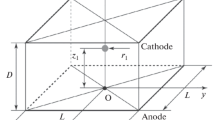Abstract
Using the experimental data on the dependence of the coefficient of ionization by electron impact \({\alpha \mathord{\left/ {\vphantom {\alpha N}} \right. \kern-0em} N}\) as a function of E/N in the gas CF4, the values of the strongly inhomogeneous electric field at the points located along the force lines are compared with those of the fields of the electron avalanches developing in them. It has been shown that the distributions of the increasing electric field of the avalanche always have the only point of intersection with the constant-field distribution. This is evidence that in the avalanche, a dipole has appeared with charges Ne ≈ Ni located at a distance of about α–1 between them. The opposite direction of the electric fields created by the power supply and the avalanche charges neutralizes the field inside the dipole down to zero. Emergence of such a region (point) in the development of electron avalanche radically changes the character of further development of the gas discharge. In fact, it is a final point in the development of the initial electron avalanche. Since the drift current stops at this point (the avalanche current circuit is broken), the electron avalanche is transformed to a plasma state; ionization by electron impacts passes due to the energy accumulated in the interelectrode capacitance of the discharge gap. In other words, the avalanche continues to develop only due to internal sources and, as a result, acquires a new spatial structure in the form of a double charge layer. As a result, the charge system transforms to a self-organizing and evolving system, which, after a series of sequential transformations, becomes the base for forming a streamer. The dynamics of a sequential transformation of the charge system to new stable structural formations is seen in the experimental data.











Similar content being viewed by others
REFERENCES
E. M. Bazelyan and Yu. P. Raizer, Lightning Discharge (Moscow Inst. Phys. Tech., Moscow, 1997) [in Russian].
B. Zh. Zalikhanov, “The plasma discharge mechanism in wire chambers in the regime of large gas gain,” Phys. Part. Nucl. Lett. 29 (1998).
B. Zh. Zalikhanov, “Specific features of electron avalanche in high gas multiplication mode,” Phys. Part. Nucl. Lett. 3, 118–130 (2006).
Yu. P. Raizer, Gas Discharge Physics (Moscow, Nauka, 1992; Springer, 2011).
J. Fischer et al., “Proportional chambers for very high counting rates based on gas mixtures of with hydrocarbons,” Nucl. Instrum. Methods A 238, 249 (1985).
E. M. Gushcin et al., “Fast beam chambers of the set-up ISTRA-M,” Nucl. Instrum. Methods A 351, 345 (1994).
A. Yu. Petrus and B. Zh. Zalikhanov, Nucl. Instrum. Methods A 485, 399 (2002).
L. G. Christophorou and J. K. Olthoff, “Electron interaction with plasma processing gasses: An update for CF4, CHF3, C2F6, and C3F8,” J. Phys. Chem. Ref. Data 28, 967 (1999).
B. Zh. Zalikhanov, “From an electron avalanche to the lightning discharge,” Phys. Part. Nucl. 47, 108–133 (2016).
L. G. Christophorou et al., J. Phys. Chem. Ref. Data 25, 1341 (1996).
C. Brown, Elementary Processes in the Plasma of a Gas Discharge (Atomizdat, Moscow, 1978).
G. Francis, Ionization Phenomena in Gases (Books on Demand, 1960; Atomizdat, Moscow, 1964).
D. A. Frank-Kamenetskii, Plasma, The Fourth State of Matter (Atomizdat, Moscow, 1963; Plenum Press, 1972).
H. Kalmar et al., “New method for constructing multiwire chambers,” Nucl. Instrum. Methods A 307, 279 (1991).
H. Kalmar et al., “Development of the method of multiwire detectors working in high rate environment,” in Proceedings of the 3rd Workshop “Physics at UNK”, Protvino, Russia, 1990, p. 31.
B. Zh. Zalikhanov, “Double charge layer in high-current electron avalanche,” Phys. Part. Nucl. Lett. 3, 211–221 (2006).
S. P. Strelkov, Introduction to the Theory of Oscillations (Nauka, Moscow, 1964) [in Russian].
F. Crawford, Waves (McGraw-Hill, 1968; Nauka, Moscow, 1976).
V. M. Romanova et al., “Stratification in the electrical explosion of thin wires,” Vopr. At. Nauki Tekh. No. 1, 284 (2013).
ACKNOWLEDGMENTS
The author is grateful to Prof. E.M. Syresin and Senior Researcher A.O. Sidorin for their support of this study and useful discussions.
The author is also grateful to Senior Researcher L.K. Lytkarin and department head of Tekhnokomplekt G.V. Tsepilov for their attentive consideration of the paper, constructive comments, and material on explosions of thin wires.
Author information
Authors and Affiliations
Corresponding author
Additional information
Translated by E. Smirnova
Rights and permissions
About this article
Cite this article
Zalikhanov, B.Z. Critical Point for Transition of an Electron Avalanche to a Streamer. Phys. Part. Nuclei Lett. 20, 84–95 (2023). https://doi.org/10.1134/S1547477123020218
Received:
Revised:
Accepted:
Published:
Issue Date:
DOI: https://doi.org/10.1134/S1547477123020218



